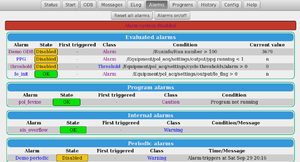Alarms Page
Links
Purpose
The purpose of the mhttpd Alarms page is to display information about the MIDAS Alarm System, and to allow the user to reset individual alarms or all alarms. In case your web browser supports the "Speech Synthesis API" from Google, a check box will be displayed for enabling Alarms to be spoken.
Access the Alarms page
The Alarms Page is accessed from the Status Page (or the other Pages) by clicking on the menu-button Alarms. The top level ODB trees will be visible as key-links (i.e.links to a key) (Figure 1).
- Note
- If "Alarms" button is not present on the Status Page, it may have been suppressed.
Features of the Alarms page
Click to enlarge thumbnails.
Figure 1 shows an example of the Alarms Page where the Alarm System is enabled and no alarms are triggered. The page displays information from the /Alarms ODB tree. At the top of the Alarms page are two buttons, Reset all alarms and Alarms on/off. The latter button will disable/enable the Alarm System. If the Alarm system is disabled, it will appear as in Figure 2.
The Alarms Page is divided into four areas, one for each of the alarm types :
Clicking on one of the alarm-links on the left hand side of the page (under heading Alarm) switches to the ODB Page displaying the contents of the /Alarms/Alarms/<alarm-name> subtree. For example, Figure 2 shows the Demo ODB alarm subtree.
In Figure 1, under heading State, the Demo ODB is shown as Disabled because the ODB key Active for that alarm is set to "n". Alarms with this key set to "y" are shown as OK .
The class for each alarm is shown as a link under the Class heading. Clicking on one of the class-links switches to the ODB Page displaying the contents of the /Alarms/Alarms/<class-name> subtree. For example, Figure 4 shows the "Caution" class subtree.
The Condition reflects the contents of the ODB Condition key for that alarm.
The Current value for Evaluated alarms displays the current value of the Condition. In the case of Alarm Demo ODB, this is the current run number.
Figure 5 shows an example of the Alarms page with the alarm pol_fevme is
Triggered . This causes an alarm banner to appear on the Status Page (see Alarm Banner).




